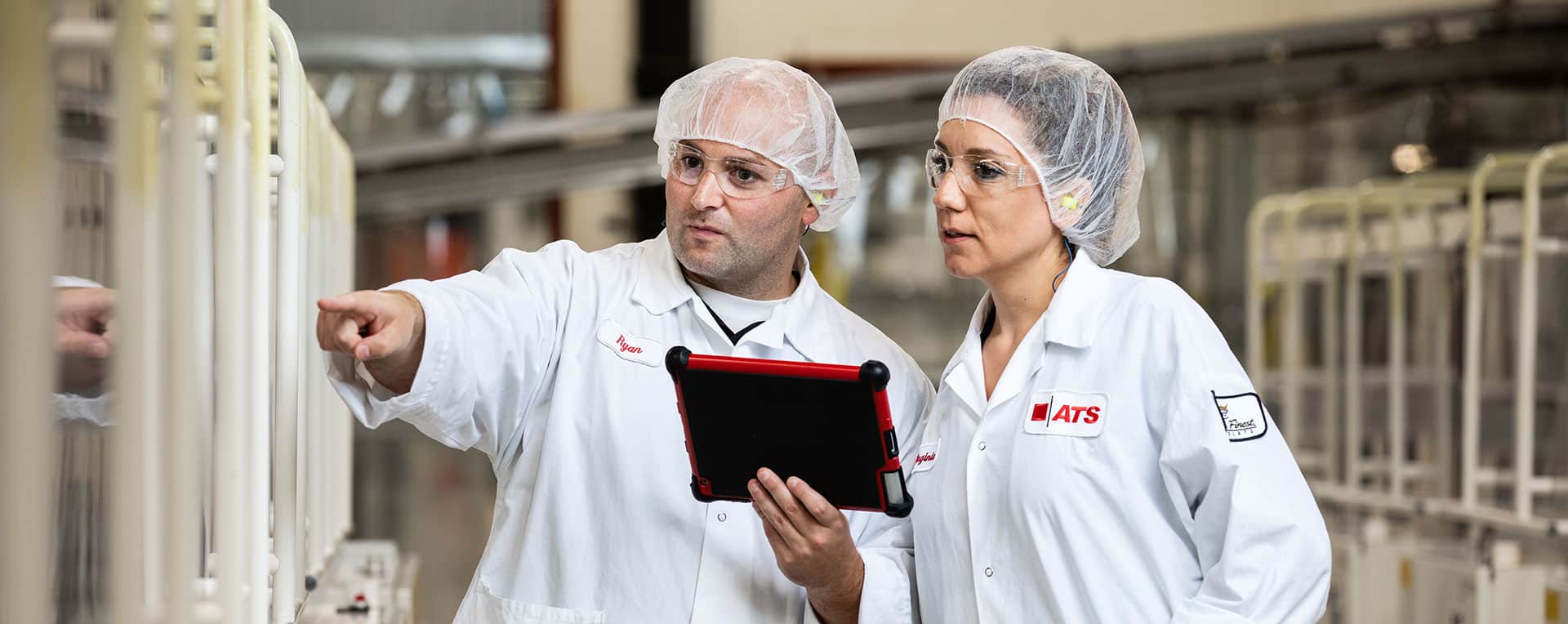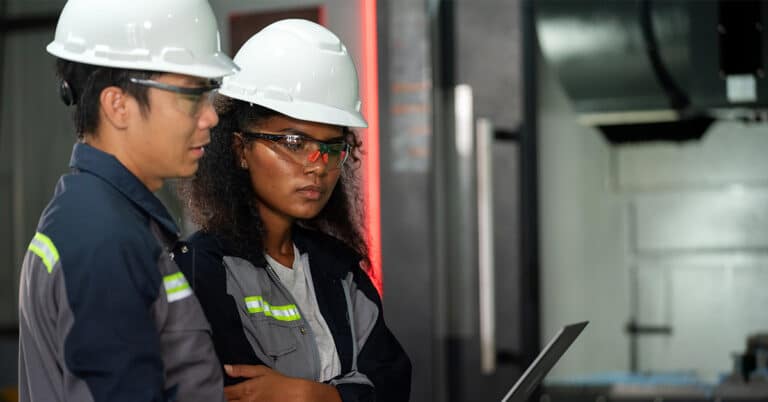No one should ever be injured at work, which is why responsible businesses prioritize safety in every area. However, industrial maintenance work — often reactive and unpredictable — can sometimes be overlooked when it comes to formal safety protocols.
That oversight can be costly. According to the National Safety Council, nearly 20% of serious workplace injuries in industrial environments are tied to maintenance activities. Unpredictable conditions, heavy machinery, and exposure to hazards like electricity, chemicals, and dust demand a proactive, structured approach to industrial maintenance safety.
This blog explores the importance of safety in maintenance operations, because industrial safety is as important as the safety of everyone else in the factory. From regulatory frameworks to modern technologies and cultural shifts, a safety-first approach must extend across every phase of the maintenance process.
After all, investing in a strong safety program isn’t only about compliance — it’s about safeguarding lives, minimizing downtime, and building long-term operational resilience.
Understanding OSHA and ANSI maintenance safety regulations
Who sets safety guidelines for maintenance workers? In the U.S., OSHA (Occupational Safety and Health Administration) plays the primary regulatory role, with support from ANSI (American National Standards Institute). Some states also operate their own OSHA-approved state plans that must meet or exceed federal standards.
How do these agencies shape safety compliance? OSHA regulations cover everything from equipment guarding to PPE requirements and electrical safety. ANSI develops voluntary consensus standards that often guide the technical specifics of compliance. ANSI standards are especially relevant for industrial maintenance technology and tools used daily in field work.
Quick facts:
- OSHA requires: Employers to identify hazards, provide training and personal protective equipment, and follow LOTO and emergency preparedness rules.
- ANSI provides: Voluntary technical standards for things like eyewear, lockout/tagout procedures, and machine safety systems.
- State plans must include: Equivalent or stricter rules, with enforcement, inspections, and penalty structures.
New OSHA regulations typically follow lengthy review and consultation periods and are enforced through audits or surprise inspections. Ultimately, it’s on facility leaders to audit their own maintenance operations and ensure compliance.
Keeping abreast of evolving standards is the key to success. Safety teams should routinely check OSHA bulletins and ANSI updates to stay compliant. Many companies assign compliance officers or hire consultants to lead gap analyses and update internal documentation.
In addition to adhering to national standards, international organizations such as ISO (International Organization for Standardization) also provide frameworks like ISO 45001 for occupational health and safety management systems. Facilities aiming for global excellence in workplace safety may align with these standards to promote a culture of continuous improvement.
Essential personal protective equipment (PPE) for maintenance workers
What PPE is critical for maintenance technicians? Industrial maintenance technicians face unique risks that vary by task, location, and tools involved. OSHA mandates employers not only provide PPE but also ensure it is properly maintained, replaced when worn, and used correctly.
Common PPE in maintenance work includes:
- Eye protection (ANSI Z87.1-rated)
- Hearing protection (earplugs or earmuffs)
- Slip-resistant and impact-resistant safety boots
- Gloves, selected based on hazard exposure (e.g., cut, chemical, electrical)
- Respiratory protection, ranging from dust masks to SCBA systems
- Hard hats to protect against falling objects and overhead hazards
- Protective clothing (e.g., flame-resistant coveralls for electrical work)
Fit testing and recordkeeping
Proper PPE fit testing is essential for items like respirators. Proper fit testing ensures that respirators form an effective seal around the face, minimizing exposure to airborne hazards. This is especially critical when maintenance technicians perform tasks that generate fine particulates, chemical vapors, or bioaerosols.
Fit testing must be repeated annually and whenever a worker’s physical condition changes (e.g., weight fluctuation or facial surgery). Because improper fit can undermine even the best PPE, training should also include instruction on how to don, doff, and check for fit seal integrity as part of any hazardous maintenance task involving respiratory risks.
OSHA requires written records of:
- PPE issued to each employee
- Dates and content of training
- Fit test results and certification dates
Regular auditing of PPE supplies and inventory should be part of standard preventive maintenance planning. In addition, supervisors should reinforce PPE compliance through visual checks and employee feedback.
The right PPE saves lives, but only when used consistently. To ensure daily adherence, some companies are integrating PPE checklists into digital CMMS workflows.
To further enhance PPE compliance, consider:
- Issuing personalized PPE kits labeled for each employee
- Using QR-coded lockers to track issuance and returns
- Creating “PPE Champions” on the floor to monitor and mentor peers
Ultimately, PPE is only as effective as the program supporting it. Employers must treat PPE use not as an individual preference but as a critical safety topic that’s monitored, discussed, and reinforced daily. When combined with a strong safety culture and digital tools like a CMMS, PPE protocols can shift from reactive measures to proactive strategies that drive measurable safety improvements.
Tool and equipment safety in maintenance
How should tools be inspected and maintained? Maintenance technicians use a broad set of tools, often under high-stress, urgent conditions. This increases the need for formal inspection procedures and maintenance practices that ensure tools are:
- Cleaned and checked before and after use
- Replaced if damaged or unsafe
- Stored correctly to prevent deterioration
Technicians should be trained in each tool’s proper use, and manufacturers should upgrade to safer tools when practical. Training logs should reflect this competency.
Organizations can go a step further by maintaining a “tool hazard register” in their CMMS platform. This register can track recurring safety issues linked to tools, prompting decisions on upgrades or retraining.
As industrial machinery evolves, so do its maintenance requirements. Safe use now extends to robotic arms, automated storage systems, and IIoT sensors, each requiring specific precautions. For instance, when maintaining robotics, workers must understand isolation protocols beyond traditional lockout/tagout.
To reduce human error, some facilities are adopting smart tools with built-in sensors that alert users to unsafe operation or overdue calibration. These innovations represent a growing shift toward digital-first industrial maintenance practices. Maintenance technicians use a wider range of tools than production workers. They must still be safe to use and fit for purpose though, and the technicians should be trained in their correct usage.
Maintenance technicians use a wider range of tools than production workers. They must still be safe to use and fit for purpose though, and the technicians should be trained in their correct usage.
Emergency preparedness and response plans
Emergencies in maintenance often involve fire, chemical exposure, electrical faults, or equipment failure. OSHA mandates a formal emergency action plan (EAP) tailored to operational risks.
Emergency plan checklist:
- Fire evacuation routes and responsibilities
- Chemical spill containment and decontamination
- Procedures for electrical shutdown or arc flash scenarios
- Lockout/tagout failure contingencies
- Communication protocols and responsibilities
Tip: Run regular emergency drills. Use your CMMS to log outcomes, assign corrective actions, and provide audit readiness.
Additionally, assign a rotating team of emergency leads trained to activate protocols on each shift. Post visual emergency flowcharts in maintenance rooms, along with location tags for fire extinguishers, spill kits, and defibrillators.
Emergency readiness should also be evaluated during routine preventive maintenance to verify the operability of exit lights, ventilation systems, alarms, and sprinkler systems. These checks should coincide with scheduled walkthroughs or inspections and be treated as a core maintenance task with clear ownership and documentation requirements.
Some organizations go even further by building digital twins of their facilities to simulate disaster scenarios. These models allow teams to refine emergency procedures and test “what-if” responses without disrupting live operations.
Best practices for maintenance safety
Routine maintenance activities must be structured around proven safety behaviors. Key strategies include:
- Clear authorization and access protocols
- A robust training program that addresses recurring risks
- Predefined and followed schedules for inspections and preventive work
- Detailed after-use checks and documentation
- Opportunities for all employees to raise concerns without retaliation
Lockout/Tagout (LOTO) remains foundational. Where real-time troubleshooting makes full LOTO challenging, customized procedures should be created by local safety leaders.
Organizations should also implement the “Five Basic Rules for Safe Maintenance”:
1. Plan and prepare for the job
2. Isolate equipment from energy sources
3. Verify zero energy state
4. Perform the task safely
5. Return equipment to service properly
Periodic refresher training and supervisor ride-alongs can reinforce these core habits. For facilities operating across multiple sites, standardizing maintenance practices and documentation through a shared CMMS platform ensures consistency in how safety is executed.
Building a strong safety culture in maintenance
Why does culture matter? Culture influences how seriously employees take protocols and whether they speak up when they see risk. The best safety outcomes come from organizations where safety is seen as everyone’s job.
Examples of safety culture initiatives:
- Anonymous hazard reporting forms or QR codes
- Visual safety scoreboards showing incident-free days
- “Safety Champion of the Month” recognition
Leadership must demonstrate accountability and participate visibly in safety audits, toolbox talks, and incident follow-up reviews. By modeling safe behaviors and reinforcing organizational safety standards, leaders help normalize safety as a daily priority rather than an occasional inspection checklist.
Other ways to promote safe maintenance culture:
- Launch cross-functional safety committees
- Provide microlearning safety videos during shift changes
- Conduct stay interviews to understand frontline safety challenges
Cultivating culture also involves setting clear safety KPIs. Examples include PPE compliance rate, LOTO audit score, and average time to resolve reported hazards. Reporting on these KPIs during team meetings can create transparency and shared goals.
Utilizing a CMMS for maintenance safety
A Computerized Maintenance Management System (CMMS) can support nearly every aspect of maintenance safety:
- Schedule preventive maintenance and safety checks
- Store safety protocols, MSDS sheets, and lockout procedures
- Log incidents and track near-misses for analysis
- Track safety training completion and certification renewals
This centralization supports both operational safety and regulatory compliance. More advanced CMMS platforms can generate safety dashboards, push real-time alerts for high-risk work orders, and trigger reminders for PPE requirements based on task type.
By integrating CMMS tools with IoT sensors and mobile devices, companies can ensure industrial maintenance safety is proactive, measurable, and transparent.
CMMS solutions also enable remote audits and mobile inspections, which are increasingly valuable in distributed or 24/7 industrial environments. With proper configuration, a CMMS becomes the digital backbone of any modern safety program.
Support for asset maintenance
Properly maintained equipment reduces risk. ATS supports manufacturers through:
- Short-term surge support with trained maintenance technicians
- CMMS implementation and optimization consulting
- Custom preventive maintenance programs designed to reduce unplanned downtime and hazard exposure
ATS helps manufacturers care for their assets with services ranging from storeroom management and short-term maintenance support to preventive and predictive maintenance. Contact us for more information.
References
Occupational Safety and Health Administration (OSHA)
U.S. Department of Labor, Occupational Safety and Health Administration. (n.d.). Occupational Safety and Health Administration. Retrieved from https://www.osha.gov
American National Standards Institute (ANSI)
American National Standards Institute. (n.d.). ISO Resources. Retrieved from https://www.ansi.org/resource-center/iso
National Safety Council (NSC)
National Safety Council. (n.d.). Policy Statement Listing. Retrieved from https://www.nsc.org/policy-statements/listing
International Organization for Standardization (ISO) – ISO 45001
International Organization for Standardization. (2018). ISO 45001:2018 – Occupational health and safety management systems – Requirements with guidance for use. Retrieved from https://www.iso.org/standard/63787.html
National Institute for Occupational Safety and Health (NIOSH)
National Institute for Occupational Safety and Health. (2024). NIOSH List of Hazardous Drugs in Healthcare Settings, 2024 (DHHS (NIOSH) Publication No. 2025-103). Retrieved from https://www.cdc.gov/niosh/docs/2025-103/default.html






